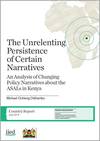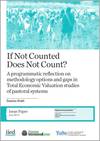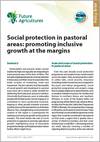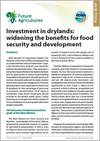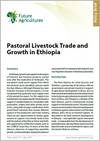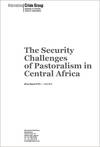The country report presents an analysis of changing policy narratives about the arid and semi-arid lands in Kenya. Kenya cannot achieve its development targets unless there are appropriate investments in the arid and semi-arid lands. These lands can make a significant contribution to national development and the failure to integrate them into the national economy is perhaps being the main reason for the failure of national development since independence. Investing in the arid lands is now a constitutional imperative and the institutional foundations for their integration into national development are now in place.
Year of publication: 2014Organization: International Institute for Environment and Development (IIED)
Topic: Climate change, Economy, Environmental services, Resilience
Language: English
Type of document: Technical
Geographical coverage: Eastern Africa
The substantial value of pastoral systems remains largely invisible to local, national and regional calculations of economic performance (for example the construction of GDP). Official data continue to be used even when their reliability is known to be poor. A complementary framework in cost-benefit analysis, known as Total Economic Valuation, is increasingly being used by NGOs and regional bodies to help put onto the map the many aspects of economic value contributed by pastoral systems– contributions that are presently not counted. This issue paper provides a practical tool for those interested in carrying out work on the Total Economic Valuation of pastoralism.
Year of publication: 2014Organization: International Institute for Environment and Development (IIED)
Topic: Economy
Language: English
Type of document: Technical
Geographical coverage: Eastern Africa, Global
For thirty years, Agonlin region in Zou department has been subject to extensive movements of national and cross-border transhumance every year: it is a seasonal movement of flocks and their shepherds in search of water and pastures. The absence or weakness of structures and hospitality infrastructure, especially transhumance corridors lead transhumant animals to cause enormous damage to farmers with immeasurable drawbacks (destruction of crop fields and fallows, cattle raiding crops , raping women, slaughtering animals, etc.)
Year of publication: 2014Organization: Individual authors
Topic: Conflict, Indigenous peoples, Organization
Language: English
Type of document: Technical, Scientific
Geographical coverage: West Africa
Vulnerability and poverty levels remain stubbornly high and arguably are deepening in many pastoral areas of the Horn of Africa. This is in spite of galloping livestock commercialisation
in these areas and their closer incorporation into wider systems of marketing, trade and
investment. The fact remains that the benefits of recent growth and investment in pastoral areas have yet to result in wider benefits for addressing food insecurity and poor nutrition. Thus, strengthening social protection systems in the region is a prerequisite for realising more inclusive growth at the pastoral margins.
This brief details the role of social protection in agendas to promote agricultural growth, highlighting areas of innovative programme design and implementation where further efforts might focus.
Year of publication: 2014Organization: Future Agricultures Consortium
Topic: Economy, Food security, Gender and youth, Indigenous peoples, Social services
Language: English
Type of document: Technical
Geographical coverage: Eastern Africa
After decades of comparative neglect, the drylands of the Horn of Africa are experiencing an unprecedented surge of investment. But uneven investment can be a barrier to formal private sector engagement; and leave pastoralists more vulnerable to shocks and ill-equipped to take advantage of processes of economic transformation.
Therefore, this publication provides recommendations for investing in drylands for the greater public good. The recommendations are made with a view to ensuring that investment in drylands reinforces poverty reduction and food security.
Year of publication: 2014Organization: Future Agricultures Consortium
Topic: Economy, Finance, Food security, Land, Social services, Value addition
Language: English
Type of document: Technical
Geographical coverage: Eastern Africa
Although Ethiopia has seen dramatic increases in formal exports, it is less recognised that pastoralist areas supply most of the animals for export. For this supply to be maintained or increased, specific livestock policy support is needed based on consultation with pastoralists, traders and other private sector actors, along with stronger coordination of the government ministries that oversee different aspects of the production and trade system.
This policy brief presents a brief overview of the eco-political landscape of livestock trade, lessons learnt from livestock and trade programmes, and policy priorities for supporting pastoral livestock marketing.
Year of publication: 2014
Organization: Future Agricultures Consortium
Topic: Economy, Indigenous peoples, Participation, Value addition
Language: English
Type of document: Technical
Geographical coverage: Eastern Africa
Into the fold: What pastoral responses to crisis tell us about the future of pastoralism in the Horn
More than ever before, pastoral areas of the Horn of Africa are coming into the fold of wider economic processes. Expropriations of land and key resources in rangelands for the establishment of private ranches and commercial farms, the expansion of roads, telecommunications, and marketing facilities to promote trade and mobility, and investments in hydrocarbons are some of the ways that pastoral areas are being newly encapsulated into regional and global capitalist development.
This paper is concerned with how pastoral livelihoods are likely to evolve in areas of the Horn of Africa where processes of incorporation are intensifying. It reports the findings of a survey of 110 Maasai households in seven sites in Laikipia on pastoral livelihoods and strategies to manage and recover from the severe drought crisis of 2008-2010.
Year of publication: 2014Organization: Future Agricultures Consortium
Topic: Climate change, Economy, Food security, Indigenous peoples, Land, Resilience, Social services, Value addition
Language: English
Type of document: Technical
Geographical coverage: Eastern Africa
In the last few years, conflicts between pastoralists and local communities have intensified because of a combination of factors: worsening security; climate change; the multiplication of migration roads, especially transnational routes; the expansion of cultivated areas and an increase in cattle herds. The report looks at three countries – Chad, Central African Republic and Democratic Republic of Congo – and explores various approaches of managing pastoral conflict and regulate transhumance.
Year of publication: 2014Organization: International Crisis Group
Topic: Conflict
Language: English, Français
Type of document: Technical
Geographical coverage: Central Africa


